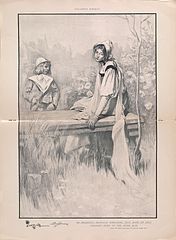The Turn of the Screw: Verskil tussen weergawes
Nuwe bladsy geskep met '{{TITELAANSIG|''The-Turn-of-the-Screw-Collier's-1A.jpg''}} {{Boek | titel = ''The Turn of the Screw'' | subtitel = | oorspr titel = | vertaler...' |
(Geen verskil)
|
Wysiging soos op 16:49, 3 Julie 2019
The Turn of the Screw
| |
|---|---|
| Skrywer | Henry James |
| Land | |
| Taal | Engels |
| Genre | |
| Uitgewer | The Macmillan Company (New York Stad) William Heinemann (Londen) |
| Uitgegee | Oktober 1898 |
The Turn of the Screw is an 1898 horror novella by Henry James that first appeared in serial format in Collier's Weekly magazine (January 27 – April 16, 1898). In October 1898 it appeared in The Two Magics, a book published by Macmillan in New York City and Heinemann in London. Classified as both gothic fiction and a ghost story, the novella focuses on a governess who, caring for two children at a remote estate, becomes convinced that the grounds are haunted.
In the century following its publication, The Turn of the Screw became a cornerstone text of academics who subscribed to New Criticism. The novella has had differing interpretations, often mutually exclusive. Many critics have tried to determine the exact nature of the evil hinted at by the story. However, others have argued that the brilliance of the novella results from its ability to create an intimate sense of confusion and suspense within the reader.
The novella has been adapted numerous times in radio drama, film, stage, and television, including a 1950 Broadway play, and the 1961 film The Innocents.
Plot
On Christmas Eve, an unnamed narrator listens to Douglas, a friend, read a manuscript written by a former governess whom Douglas claims to have known and who is now dead. The manuscript tells the story of how the young governess is hired by a man who has become responsible for his young nephew and niece after the deaths of their parents. He lives mainly in London but also has a country house, Bly. He is uninterested in raising the children.
The boy, Miles, is attending a boarding school, while his younger sister, Flora, is living in a summer country house in Essex. She is currently being cared for by Mrs. Grose, the housekeeper. Miles and Flora's uncle, the governess' new employer, gives her full charge of the children and explicitly states that she is not to bother him with communications of any sort. The governess travels to her new employer's country house and begins her duties.
Miles soon returns from school for the summer just after a letter arrives from the headmaster stating that he has been expelled. Miles never speaks of the matter, and the governess is hesitant to raise the issue. She fears there is some horrible secret behind the expulsion but is too charmed by the adorable young boy to want to press the issue. Soon thereafter, around the grounds of the estate, the governess begins to see the figures of a man and woman whom she does not recognize. These figures come and go at will without ever being seen or challenged by other members of the household, and they seem to the governess to be supernatural. She learns from Mrs. Grose that the governess' predecessor, Miss Jessel, and another employee, Peter Quint, had had a sexual relationship. Before their deaths, Jessel and Quint spent much of their time with Flora and Miles, and this fact has grim significance for the current governess when she becomes convinced that the two children are secretly aware of the ghosts' presence.
Later, without permission, Flora leaves the house while Miles is playing music for the governess. The governess notices Flora's absence and goes with Mrs. Grose in search of her. They find her in a folly on the shore of the lake, and the governess is convinced that Flora has been talking to the ghost of Miss Jessel. When the governess finally confronts Flora, the girl denies seeing Miss Jessel, but the Governess forces the girl to say Miss Jessel's name. That releases Miss Jessel's power over the girl. However, Flora demands never to see the governess again. At the governess' suggestion, Mrs. Grose takes Flora away to her uncle, leaving the governess with Miles, who that night at last talks to her about his expulsion; the ghost of Quint appears to the governess at the window. The governess shields Miles, who attempts to see the ghost. The governess tells Miles he is no longer controlled by the ghost and then finds that Miles has died in her arms, and the ghost has gone.
Publikasie geskiedenis
The Turn of the Screw was first published in the magazine Collier's Weekly, serialised in 12 instalments (27 January – 16 April 1898). The title illustration by John La Farge depicts the governess with her arm around Miles. Episode illustrations were by Eric Pape.[1]
-
"The next night, by the corner of the hearth, in the best chair … Douglas began to read"
-
"He did stand there!—But high up, beyond the lawn and at the very top of the tower"
-
"Holding my candle high, till I came within sight of the tall window"
-
"He presently produced something that made me drop straight down on the stone slab"
-
"I must have thrown myself, on my face, on the ground"
In October 1898 the novella appeared with the short story "Covering End" in a volume titled The Two Magics, published by Macmillan in New York City and by Heinemann in London.[2]
James revised The Turn of the Screw ten years later for his New York Edition.[3] In The Collier's Weekly Version of The Turn of the Screw (2010), the tale is presented in its original serial form with a detailed analysis of the changes James made over the years. Among many other revisions, James changed the children's ages.[4]
Aanpassings
The Turn of the Screw was al die onderwerp van 'n reeks aanpassings en bewerkings in 'n variëteit van media, en hierdie aanpassings is self al geanaliseer in die akademiese literatuur betreffende Henry James en neo-Victoriaanse kultuur.[5] Dit was aangepas tot The Turn of the Screw (opera) deur Benjamin Britten, wat sy buiging in 1954 ontvang het,[6] en die opera is reeds by verskeie geleenthede verfilm.[7] Die novelle was aangepas as 'n balletstuk (1980) deur Luigi Zaninelli,[8] en ook apart as 'n ballet (1999) deur Will Tucket vir die Koninklike Balletgeselskap.[9] Harold Pinter het die toneelstuk The Innocents (1950) geregisseer, te wete 'n Broadway teaterstuk wat 'n aanpassing was van The Turn of the Screw,[10] en 'n gevolglike gelyknamige verhoogstuk, aangepas deur Rebecca Lenkiewicz was in Januarie 2013 aangebied in 'n mede-produksie met Hammer Film Productions by die Almeida Teater in Londen.[11]
Uitgawes

Pre-millennium
- The Turn of the Screw: Authoritative Text, Contexts, Criticism, geredigeer deur Robert Kimbrough (New York: W.W. Norton & Company, 1966) [no ISBN].
- The Tales of Henry James, geredigeer deur Edward Wagenknecht (New York: Frederick Ungar Publishing Co. 1984) ISBN 0-8044-2957-X.
- The Aspern Papers en The Turn of the Screw, met 'n inleiding en notas deur Anthony Curtis (Harmondsworth: Penguin, 1986) ISBN 9780141439907. (Sluit uittreksels van die New Yorkse Voorwoord tot beide novelles in. Sluit egter nie 'n lys van voorgestelde verdere leeswerk in nie).
- The Turn of the Screw: Authoritative Text, Contexts, Criticism, geredigeer deur Deborah Esch en Jonathan Warren (New York: W.W. Norton & Company, 1999) ISBN 0-393-95904-X. (Bied 'n seleksie van kritiek, insluitende 'n uittreksel van Edmund Wilson se studie van die novelle).
Post-millennium
- The Turn of the Screw and Other Stories, geredigeer deur T.J. Lustig (Oxford: Oxford University Press, 2008) ISBN 978-0-199-53617-7.
- The Collier's Weekly Version of The Turn of the Screw, geredigeer deur Peter G. Beidler (Seattle: Coffeetown Press, 2010) ISBN 978-1-60381-018-0.
- The Turn of the Screw and Other Stories, geredigeer deur Kimberly Reed (Peterborough: Broadview Press, 2010) ISBN 978-1-770-48255-5.
- The Turn of the Screw, geredigeer deur David Bromwich (New York: Penguin Classics, 2011) ISBN 978-0-141-44135-1.
Verwysings
- ↑ Orr 2009, p. 23.
- ↑ James, Henry (1996). Complete Stories, 1892–1898. New York: Library of America. p. 941. ISBN 978-1-883011-09-3.
- ↑ Orr 2009, p. 24.
- ↑ Henry James. Beidler, Peter G. (red.). The Collier's Weekly Version of The Turn of the Screw. Coffeehouse Press.
- ↑ name="Dinter">Dinter, Sandra (2012). "The mad child in the attic: John Harding's Florence & Giles as a neo-victorian reworking of The Turn of the Screw". Neo-Victorian Studies. 5 (1): 60–88.
- ↑ name="Dinter"
- ↑ Haralson & Johnson 2009, p. 293.
- ↑ name="Brown">Brown, Monika (1998). "Film Music as Sister Art: Adaptations of 'The Turn of the Screw.'". Mosaic (Winnipeg). 31 (1).
- ↑ Jays, David (July 1, 2006). "Ballet – From page to stage". Financial Times. Retrieved January 5, 2015.
- ↑ Baker, William (2008). Harold Pinter. A&C Black. p. 32. ISBN 978-0-8264-9970-7.
- ↑ Masters, Tim (23 November 2012). "Hammer takes first steps on stage in Turn of the Screw". BBC News. Besoek op 13 Februarie 2013.
Werke aangehaal
- Haralson, Eric L.; Johnson, Kendall (2009). Critical Companion to Henry James: A Literary Reference to His Life and Work. Infobase Publishing. ISBN 978-1-4381-1727-0.
{{cite book}}: Ongeldige|ref=harv(hulp) - Heilmann, Ann (2010). "The Haunting of Henry James: Jealous Ghosts, Affinities and The Others". In Arias, Rosario; Pulham, Patricia (reds.). Haunting and Spectrality in Neo-Victorian Fiction: Possessing the Past. Palgrave Macmillan. ISBN 978-0-230-24674-4.
{{cite book}}: Ongeldige|ref=harv(hulp) - Hischak, Thomas S. (2012). American Literature on Stage and Screen: 525 Works and Their Adaptations. McFarland. ISBN 978-0-7864-9279-4.
{{cite book}}: Ongeldige|ref=harv(hulp) - Orr, Leonard (2009). James' The Turn of the Screw: A Readers Guide. London, New York: Bloomsbury. ISBN 978-0-8264-3019-9.
{{cite book}}: Ongeldige|ref=harv(hulp) - Simon, Linda (2007). The Critical Reception of Henry James: Creating a Master. London: Camden House. ISBN 978-1-571-13319-9.
{{cite book}}: Ongeldige|ref=harv(hulp) - Slide, Anthony (2013). Fifty Classic British Films, 1932-1982: A Pictorial Record. Courier Corporation. ISBN 978-0-486-14851-9.
{{cite book}}: Ongeldige|ref=harv(hulp) - Tintner, Adeline R. (1998). Henry James's Legacy: The Afterlife of His Figure and Fiction. Louisiana State University Press. ISBN 978-0-807-12157-3.
{{cite book}}: Ongeldige|ref=harv(hulp)
Verdere leeswerk
- Smith, Allan Lloyd. "A Word Kept Back in "The Turn of the Screw". In Clive Bloom (ed), Creepers: British Horror and Fantasy in the Twentieth Century. London and Boulder CO: Pluto Press, 1993, pp. 47–63.
Eksterne skakels
| Wikimedia Commons bevat media in verband met The Turn of the Screw. |
| Wikisource bevat oorspronklike teks in verband met |
Primêre bronne
- The Turn of the Screw by Project Gutenberg (1898 boek weergawe)
- The Turn of the Screw via American Literature (full text)
- Author's preface to the New York Edition text of The Turn of the Screw (1908)
Sekondêre gesprekke
- Note on the various texts of The Turn of the Screw at the Library of America web site.
- Synopsis of The Turn of the Screw from the English Touring Opera
- turnofthescrew.com A History of Its Critical Interpretations 1898–1979 Edward J. Parkinson, PhD







